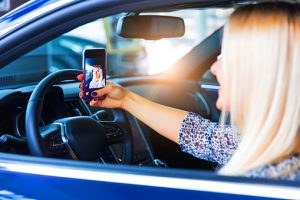 Distracted driving is all around us every day. Smartphones have become such an integral part of our daily lives and culture, it’s hard for many people to put them down – no matter where they are. A slew of apps now allows users to easily use their phones for just about any kind of function.
Distracted driving is all around us every day. Smartphones have become such an integral part of our daily lives and culture, it’s hard for many people to put them down – no matter where they are. A slew of apps now allows users to easily use their phones for just about any kind of function.
For many drivers, sending a text, checking their notifications, and video chatting behind the wheel is habitual. Some are under the impression that they’ve mastered the skill of multitasking and have been doing so for years without causing a traffic accident.
This type of behavior is the most dangerous to other road users. When drivers are confident in their ability to manipulate a smartphone behind the wheel, they’re not prepared for the unexpected. Within seconds, traffic could come to a stop, another vehicle could turn from an intersection, or a pedestrian could be using a crosswalk.
How prevalent is smartphone distraction?
A 2018 study conducted by the Insurance Institute for Highway Safety, Highway Loss Data Institute (IIHS, HLDI) reports that smartphone distraction was a factor in more than 800 fatal crashes across the United States in 2017. These numbers are just estimates and don’t actually represent the true number of road deaths attributed to smartphone distraction.
While fewer drivers are talking on phones behind the wheel, overall handling of smartphones has increased by 57 percent between 2014-2018. The 2017 death toll prompted a team of IIHS researchers to find out how prevalent smartphone distraction behind the wheel is. They staked out at traffic lights, straight sections, and roundabouts in four different communities in northern Virginia. They found that drivers are more likely to engage in smartphone distraction when stopped at traffic lights.
More importantly, they found that around 23 percent of the drivers observed used smartphones behind the wheel. The tasks included:
- Talking on a smartphone
- Handling a smartphone
- Holding and looking at a smartphone
- Using a smartphone through a hands-free Bluetooth device
- Wearing headphones
Other forms of distraction not involving phone use included handling infotainment systems, using other electronic devices, singing, talking, eating, drinking, smoking cigarettes, and taking care of hygiene or appearance.
Distracted driving remains a common problem in Washington
The Columbian cites a 2018 ranking of states by QuoteWizard that focuses on distracted driving. Washington ranked 10th worst in the nation when it came to distracted driving. Vancouver ranked 20th among Washington cities for distracted driving.
During that same year, lawmakers passed a law prohibiting drivers from handling electronic devices behind the wheel – even when stopped at traffic lights.
Distracted driving is now a primary offense, which means police can pull over drivers seen holding electronic devices and cite them. Drivers may be ticketed for using a hand-held cell phone while driving, stopped in traffic, or at a stop light and will receive a ticket that costs at least $136 for a first offense and $234 for a second offense within five years. Such offenses are considered moving violations by the State of Washington and will be reported to the violator’s insurance company.
Other forms of distracted driving, such as eating, smoking, or grooming, are secondary offenses. This means that drivers can only be cited if they are pulled over for another infraction. Fines for secondary offenses are $99.
While law enforcement may do their best to deter distracted driving, be aware that some motorists have a crafty way of getting away with it. That means at any given moment, a distracted driver could be tailing you, in the lane next to you, or approaching the four-way intersection where you have the right of way.
If you or a loved one was injured in a crash, you need an experienced and knowledgeable car accident attorney in your corner. Put your trust in The Scott Law Firm, PLLC, based in Vancouver. Contact us today for a free consultation.
